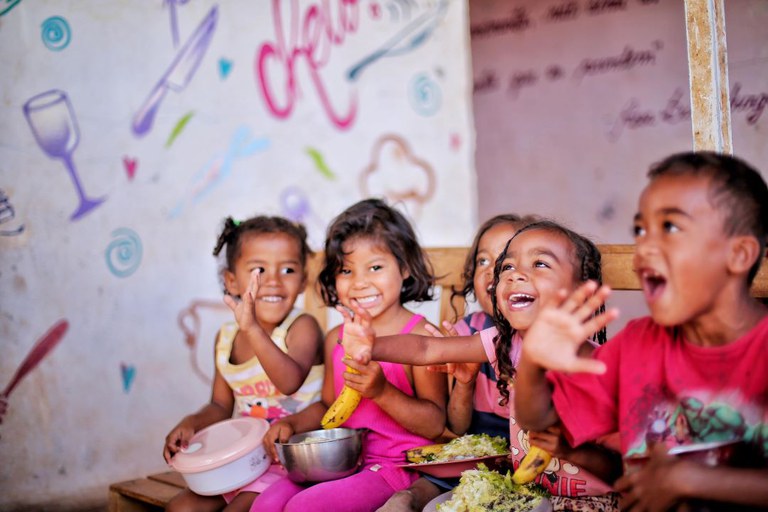Notícias
POVERTY REDUCTION
IBGE: 8.7 Million People Lifted Out of Poverty in 2023

The study credits income transfer programs as essential to reducing poverty and extreme poverty. Image: Estevam Costa / PR
From 2022 to 2023, the percentage of Brazil’s population with a per capita household income below the poverty line set by the World Bank dropped from 31.6% to 27.4%. This is the lowest level since 2012.
In numerical terms, the population in poverty fell from 67.7 million to 59 million. In just one year, 8.7 million people were lifted out of poverty. These data come from the Synthesis of Social Indicators [Síntese de Indicadores Sociais/SIS] released on Wednesday, December 4, by the Brazilian Institute of Geography and Statistics [Instituto Brasileiro de Geografia e Estatística /IBGE].
Over the same period, the proportion of the population living below the extreme poverty line dropped from 5.9% to 4.4%, also the lowest since 2012 — and, for the first time, below 5%. In absolute numbers, this represents a decrease from 12.6 million to 9.5 million. In one year, 3.1 million people were lifted out of extreme poverty.
The IBGE's analysis uses the World Bank's Purchasing Power Parity lines, which monitor Sustainable Development Goal 1 (Eradication of Poverty). The World Bank defines poverty as a per capita income of BRL 665 per month within a household, and extreme poverty as BRL 209 per month.
SOCIAL PROGRAMS — The study emphasizes that the existence of social cash transfer programs is directly linked to the results. The projection indicates that without these programs, the percentage of people in extreme poverty in 2023 would have increased from 4.4% to 11.2%, while the percentage in poverty would have risen from 27.4% to 32.4%.
BENEFITS — From 2022 to 2023, the proportion of people living in households receiving social benefits rose from 25.8% to 27.9%. In 2020, the highest point in the series, this figure reached 36.8%, due to pandemic-related government aid. In 2023, about 51% of people in rural areas lived in households receiving social benefits, compared to 24.5% in urban areas.
BOLSA FAMÍLIA PROGRAM — Among children aged 0-14, 42.7% lived in households receiving benefits. In other words, social programs affect the lives of two out of every five children in Brazil. The revamped Bolsa Família program, for example, now includes an additional BRL 150 per month for each child aged 0-6 in the beneficiary's family, plus an additional BRL 50 for each child and adolescent aged 7-18, as well as for pregnant women and breastfeeding mothers.
REGIONAL INEQUALITIES — The highest poverty rates were found in the Metropolitan Arcs and the interior of the North and Northeast regions. The highest rates were recorded in the following areas: Vale do Rio Purus (Amazonas), with 66.6%; Maranhão Coast and Baixada, with 63.8%; and the outskirts of Manaus (Amazonas), with 62.3%. These rates are significantly higher than the national average of 27.4%. In other parts of the country, areas such as the Metropolitan Area of Cuiabá (Mato Grosso), the Integrated Area of Brasília and Goiás, and the Metropolitan Arc of Nova Iguaçu (Rio de Janeiro) showed relatively high poverty levels, between 27.4% and 48.8%. “The analysis by strata highlights regional inequality, as data from the South, Southeast, and Midwest regions show the lowest values,” said Leonardo Athias, SIS manager.
OCCUPATION — Among employed people, fewer than 1% were considered extremely poor in 2023, while the proportion of extremely poor unemployed people reached 14.6%. Similarly, the percentage of poor employed individuals (14.2%) was much lower than the proportion of poor unemployed individuals (54.9%). “These figures indicate that poverty exists among segments of the employed population, likely due to social vulnerability within certain labor market sectors. However, poverty and extreme poverty are less severe among employed workers than among the unemployed,” said Simões.
“NEM NEM” — The total number of young people aged 15-29 who were neither studying nor employed reached 10.3 million (21.2%) in 2023, the lowest figure and rate since 2012. According to Denise Guichard, an IBGE analyst, this reduction is due to improvements in the labor market, an increase in young people who are both studying and working, and demographic changes that are gradually reducing the younger population. One key finding is that the lower the income bracket, the higher the proportion of young people aged 15-29 who are neither studying nor working. In 2023, 21.2% of young people were in this situation, but among the wealthiest 10% of households, only 6.6% of young people were not in education or employment. In contrast, in the lowest 10% of income households, 49.3% of young people (almost half) were not studying or working.
RACIAL INEQUALITIES — Among the 10.3 million young people aged 15-29 who were neither studying nor employed in 2023, significant gender and racial disparities persist. Black or brown women made up 4.6 million (45.2%) of this group, while white women accounted for 1.9 million (18.9%). Black or brown men represented 2.4 million (23.4%), and white men, 1.2 million (11.3%).
EMPLOYMENT — The total number of employed individuals in 2023 was the highest since 2012: 100.7 million, an increase of 3.7 million people (3.8%) compared to 2022. The increase was seen both among workers with formal contracts (2 million more) and those without formal contracts (1.7 million more). In 2023, the employment rate for the total population was 57.6%. For men, the rate was 67.9%, compared to 47.9% for women, a 20-percentage-point gap that has remained largely unchanged since 2012.
INFORMALITY — From 2022 to 2023, the proportion of informally employed people in Brazil’s workforce remained statistically stable, shifting from 40.9% to 40.7%. However, the informality rate was 45.8% among black or brown workers, compared to 34.3% among white workers. These results reflect long-standing inequalities.

